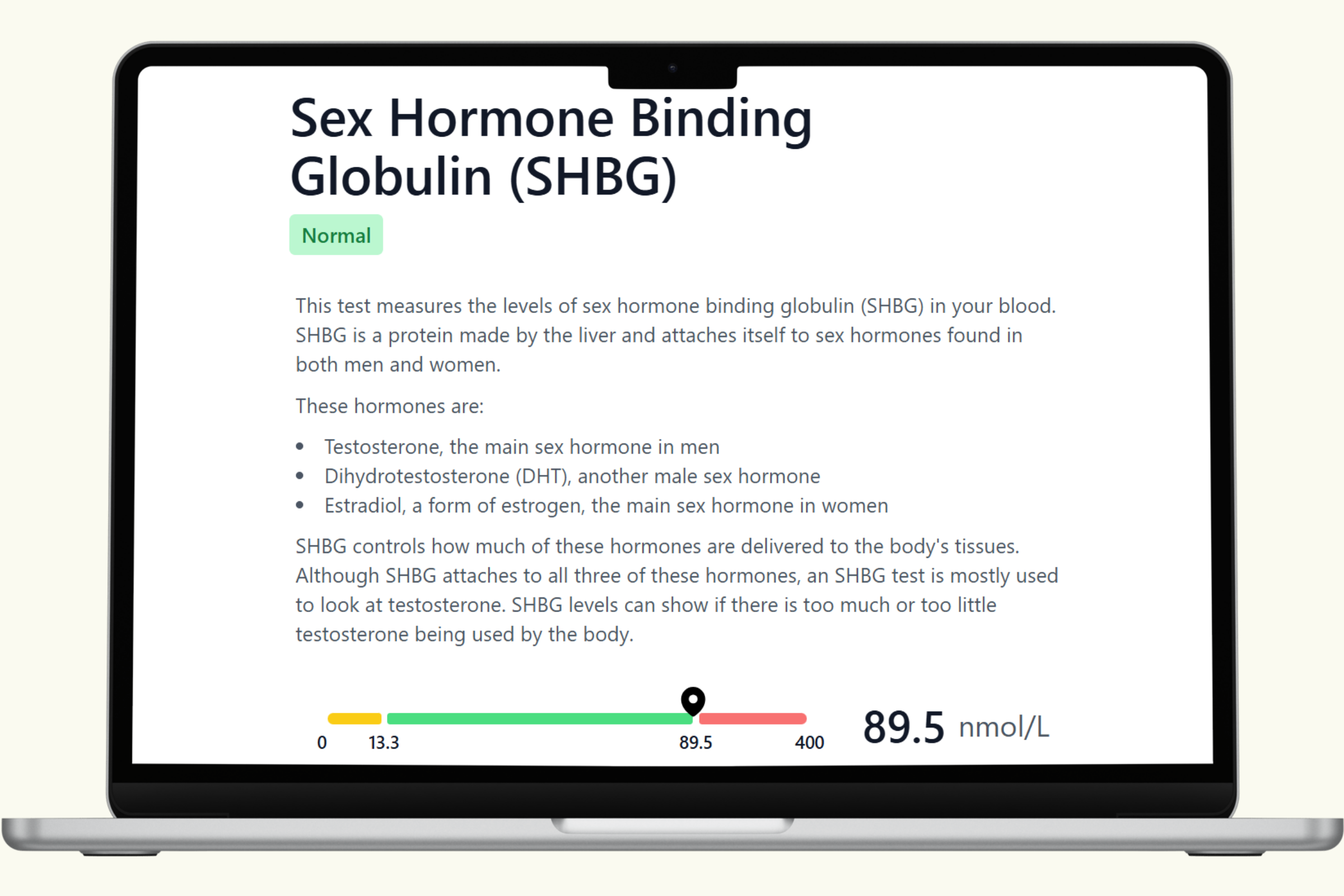Sex Hormone-Binding Globulin (SHBG) Blood Test: Regulating Hormone Availability in Men
Hormones like testosterone and estrogen are powerful regulators of male health, but only a small fraction of them are freely available for use by the body. The majority circulate in the blood attached to proteins, with one of the most important being sex hormone-binding globulin (SHBG). The SHBG Blood Test, included in the PlexusDx Men’s Health & Wellness Blood Test, provides crucial insight into how much testosterone and estrogen are truly accessible to cells.
This test is performed at home using a simple dried blood spot collection with an ADX card, making it easy to understand your hormone balance without needing to visit a clinic.
What is SHBG?
SHBG is a protein produced in the liver that binds tightly to sex hormones, particularly testosterone and estrogen. Once bound, hormones are less biologically active. By controlling how much hormone remains free and unbound, SHBG plays a key role in determining how much testosterone or estrogen is actually available for tissues like muscles, bones, and the brain.
This means that even if total testosterone appears normal, high or low SHBG levels can dramatically affect the amount of free testosterone in circulation, which is the form that truly matters for biological activity.
Why SHBG Matters for Men
1. Sexual Health and Libido
SHBG influences how much free testosterone is available to support libido, erectile function, and reproductive health. Elevated SHBG may leave less testosterone free, contributing to symptoms such as low sex drive or erectile dysfunction.
2. Fertility
By regulating free testosterone and estrogen levels, SHBG impacts sperm production and reproductive potential. Imbalances may be linked to infertility in men.
3. Hormone Balance and Metabolism
SHBG levels reflect more than just sex hormone activity. They are influenced by thyroid function, liver health, body weight, and insulin sensitivity, making SHBG an important biomarker for overall metabolic and endocrine balance.
4. Interpreting Testosterone Results
Doctors often order SHBG testing when total testosterone results do not match symptoms. For example, a man may have normal total testosterone but still experience fatigue, low libido, or infertility due to elevated SHBG binding up too much of the hormone.
How SHBG is Measured
The PlexusDx Men’s Health & Wellness Blood Test measures SHBG directly from a dried blood spot sample. Because SHBG is a stable protein, it can be accurately measured at home and used alongside testosterone and estradiol levels to give a complete picture of hormone availability and balance.
Reference Ranges for SHBG in Men
Reference values may vary by laboratory, but commonly reported ranges for adult men are:
- Standard (conventional) range: 10 – 57 nmol/L
- Functional/optimal range: 20 – 45 nmol/L
Levels outside these ranges may indicate disrupted hormone regulation or underlying metabolic conditions.
What High SHBG Can Mean
Elevated SHBG levels reduce the amount of free testosterone available, even if total testosterone is normal. Causes of high SHBG include:
- Hyperthyroidism
- Liver disease
- Aging
- Certain medications (such as anticonvulsants or HIV therapies)
- Low insulin or calorie-restricted diets
Symptoms of high SHBG include low libido, infertility, reduced muscle mass, fatigue, and mood changes due to reduced bioavailable testosterone.
What Low SHBG Can Mean
Low SHBG increases free testosterone, but it is not always beneficial. Causes of low SHBG include:
- Obesity
- Insulin resistance and type 2 diabetes
- Hypothyroidism
- Polycystic ovary syndrome (in women)
- Excessive androgen (testosterone) production or supplementation
In men, low SHBG may be linked to metabolic syndrome, fatty liver disease, or elevated cardiovascular risk. It can also complicate the interpretation of testosterone results, since low SHBG may falsely suggest higher hormone activity.
Why You Should Get Your SHBG Checked
SHBG testing provides context for interpreting testosterone and estrogen levels, helping identify whether symptoms are due to hormone imbalance or altered hormone availability. Understanding your SHBG levels can help:
- Clarify why symptoms persist despite normal testosterone results
- Guide safe and effective hormone replacement therapy (HRT or TRT)
- Evaluate risks for infertility, metabolic syndrome, or thyroid disorders
- Support long-term hormone and metabolic health
With the PlexusDx Men’s Health & Wellness Blood Test, SHBG is measured alongside testosterone, free testosterone, estradiol, and luteinizing hormone, offering a complete picture of male hormone balance through an easy at-home collection.
Conclusion
SHBG may not be as well-known as testosterone, but it plays a critical role in regulating how much hormone is truly available to the body. Both high and low SHBG can impact libido, fertility, metabolism, and long-term health. By testing SHBG along with other key hormones, men gain deeper insights into their health and can work with their healthcare provider to develop targeted strategies for balance and vitality.
The PlexusDx Men’s Health & Wellness Blood Test makes it easy to measure SHBG at home, giving men the knowledge they need to better understand their hormone balance and overall wellness.

Share:
Testosterone Blood Test
Thyroid-Stimulating Hormone (TSH) Blood Test